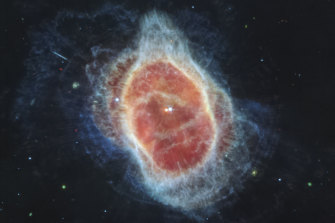NASA on Tuesday unveiled a new set of images from its powerful new space telescope, including a foamy blue and orange shot of a dying star.
The first image from the multibillion-dollar James Webb Space Telescope was released on Monday at the White House — a jumble of distant galaxies that went deeper into the cosmos than humanity has ever seen.
The Southern Ring Nebula pictured for the first time in mid-infrared light. It is a hot, dense white dwarf star, according to NASA. Credit:NASA, ESA, CSA, STScI via AP
Four additional photos were released on Tuesday, including more cosmic beauty shots.
With one exception, the latest images showed parts of the universe seen by other telescopes, but Webb’s sheer power, distant location off Earth and its use of the infrared light spectrum showed them in a new light.
“Every image is a new discovery and each will give humanity a view of the humanity that we’ve never seen before,” NASA administrator Bill Nelson as he described images showing “the formation of stars, devouring black holes.”
Webb’s use of the infrared light spectrum allows the telescope to see through the cosmic dust and “see light from faraway light from the corners of the universe,” he said.
European Space Agency director general Josef Aschbacher said it would change our understanding of the universe.
The European and Canadian space agencies joined NASA in building the powerful telescope.
The images released on Tuesday were of:
- The Southern Ring Nebula, which is sometimes called “eight-burst”. About 2500 light-years away, it shows an expanding cloud of gas surrounding a dying star. A light-year is 5.8 trillion miles.
- Carina Nebula, one of the bright stellar nurseries in the sky, about 7600 light-years away.
- Five galaxies in a cosmic dance, 290 million light-years away. Stephan’s Quintet was first seen 225 years ago in the constellation Pegasus.
- A blueish giant planet called WASP-96b. It’s about the size of Saturn and is 1150 light-years away. A gas planet, it’s not a candidate for life elsewhere but a key target for astronomers.
The images were released one by one at an event at NASA’s Goddard Space Centre.
The world’s biggest and most powerful space telescope rocketed away last December from French Guiana in South America. It reached its lookout point 1.6 million kilometres from Earth in January.
Then the lengthy process began to align the mirrors, get the infrared detectors cold enough to operate and calibrate the science instruments, all protected by a sunshade the size of a tennis court that keeps the telescope cool.
Webb is considered the successor to the highly successful but ageing Hubble Space Telescope.
AP
The Morning Edition newsletter is our guide to the day’s most important and interesting stories, analysis and insights. Sign up here.
Most Viewed in World
From our partners
Source: Read Full Article
